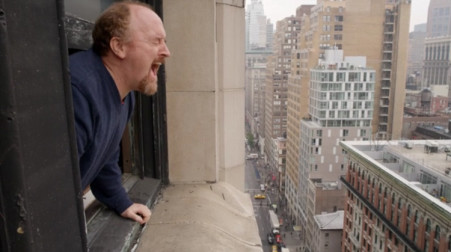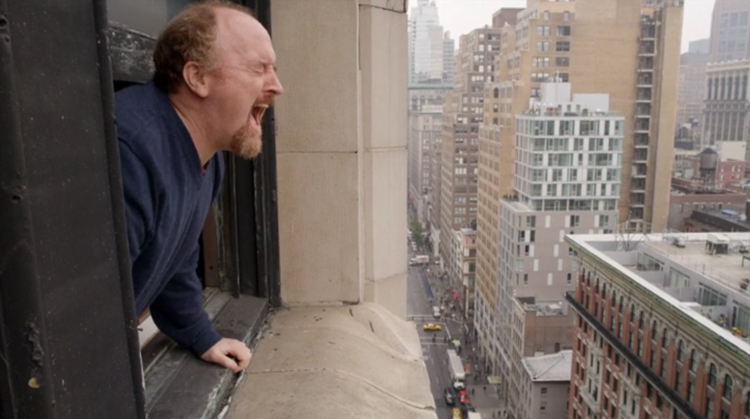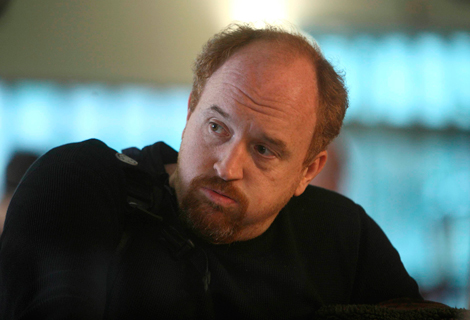In an episode of Jerry Seinfeld’s Comedians in Cars Getting Coffee, Louis CK takes Seinfeld out on his boat on the Hudson River. Looking across the water and admiring the skyline, Louis says, “New York makes me crazy. I love New York City. I love the different brick colors and the water towers.” It is a telling observation for the most part because it is not funny nor is it meant to be. It serves as a reminder that not everything that Louis CK is up to in his eponymously titled FX series is about merely getting laughs.
This relatively offhand comment—shoehorned between a couple of much funnier anecdotes—also gets at the things that make Louie, the TV show, great. It alludes to CK’s generally uncanny ability to capture a sense of place that is directly linked to both color (“the different brick colors”) and the psychology of the city’s inhabitants (“New York makes me crazy”). For all the praise heaped upon Louie as a comedian, not enough has been said about his talents as a director, or how the sophisticated visual style of Louie helps to carry the weight of his often thematically complex material.

Scene from Season 4, Episode 8, “Elevator: Part 4,” Louie goes to window in therapy session to let loose a primal scream.
One scene in Season 4’s Episode 7, “Elevator: Part 4,” epitomizes his sensibility as an auteur. Louie is in couples’ therapy with his ex-wife. The complex psychodynamics of their relationship are being articulated while we also see the bleak, cold and gray cityscape of New York through the office window. In the midst of talking about how their daughters handled the divorce, Louie stands up, walks over and puts his head out of the window to let loose a primal scream. This jarring, surreal moment is a good example of how he uses color—often, specifically, color temperature—and the city itself to express emotional undercurrents in his characters. Here, the shift from inside to the bleak city exterior dramatizes the shift from externalized psychology to the purely internal: the outside is Louie’s inside, emotionally.
The scene is striking not just for the way that it perfectly captures something about how New York looks and feels in the winter but for how the cityscape itself might become a mirror for our feelings. Like dozens of other moments during the show’s five-season run, it perfectly captures an essence of New York—not a gestalt of the city, per se, but a unique essence: what a specific block or hallway in New York is like at a particular time.
His choices of interiors and locations may have as much to do with his color sensibility as with narrative choices. Similarly, faces, as he depicts them, often have a uniquely corporeal yet aestheticized quality. He is less inclined to gloss over imperfections in the manner of most commercial television than he is to put flesh generally (often his own) directly under the microscope. By illuminating its flaws and showing people’s faces (wrinkles and all), he can find a kind of beauty usually avoided on television.
The use of his own relatively unglamorous face is typical of this. Its fleshy, freckled, pink and orange visage is filmed as if it were, itself, an inherently formal or painterly device. His puffy ginger slab of a head is often situated against a particular cast of institutional yellow (a bit drab and often fluorescently, starkly lit). This might be physically unflattering to him, but it is also genuinely exquisite and painterly. One can sense, also, his interest in color as a quality in itself. That is, he uses color to explore the affective possibilities of film rather than film as a way of merely illustrating the colors of things.
This knack for color and light is epitomized, however, not by any particular color, but what is sometimes described as its absence: a pure velvety darkness from which his figures seem, at times, to emerge—almost as if darkness was a velvety material or matrix which subsumes them. He uses this device frequently, but the most striking instance occurs in Season 5’s episode: “Untitled.” Where Louie has trafficked in dream sequences and often absurdly dreamlike twists on reality in other episodes, this one contains its most extended dream sequence.
The episode is structured in a way that it is hard to tell where Louie’s oddball version of “reality” ends and its dream sequence begins. Nevertheless, we are given our first definitely surreal moment when he opens his apartment door upon a fathomless dark void. This darkness is interrupted only when a nearly faceless, tanned, rubbery, figure—a kind of lanky terrifying gremlin—emerges suddenly from it and pounces on Louis. The scene recalls the recent art film, Under the Skin, which theorized darkness as a tangibly goopy material—one from which terrifying figures and nightmarish dreamscapes might emerge.
This also calls to mind and, in turn, dramatizes, a line from the Tao Te Ching: “Darkness within darkness/ the gateway to all understanding.” The episode as a whole, also, echoes a Season 2 episode (“Country Drive”) where Louie lectures his two daughters for complaining about being bored: “I’m bored is a useless thing to say. You live in a great big vast world that you’ve seen none percent of. Even the inside of your own mind is endless. It goes on forever, inwardly, do you understand?”
In the end, Louie determines that his nightmares are brought on by a crisis of conscience. Earlier, he had declined to help a woman (his daughter’s friend’s recently divorced mother) move a fish tank. Once he does consent to do this favor, not only do the nightmares end, but he ends up, in a rather comedic aside, vigorously humping the attractive divorcee atop a washing machine.
Here is the perfect Louie episode. It encapsulates all the ways in which darkness, sex, our moral conscience, comedy, light, terror and the utterly absurd are all intertwined. Here, we might say, Louis is offering a kind of typically profane yet heartfelt advice—a twist on the Tao Te Ching: Know the darkness (comedic, psychological and cinematographic). Not only are these the gateway(s) to all understanding, but they just might get you laid.






















0 Comments